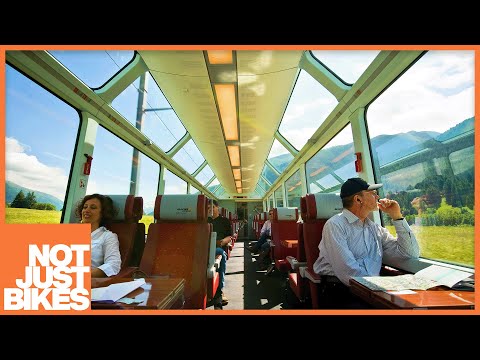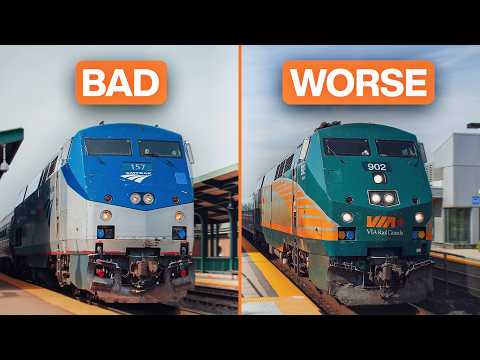L.A. residents are finding creative (and simple) ways to disable disruptive Waymo robotaxis (as I predicted long ago would come to pass with autonomous vehicles).
https://www.cnn.com/2025/06/25/us/santa-monica-waymo-battles
L.A. residents are finding creative (and simple) ways to disable disruptive Waymo robotaxis (as I predicted long ago would come to pass with autonomous vehicles).
https://www.cnn.com/2025/06/25/us/santa-monica-waymo-battles
@lauren Human-driven taxis are never going to replace private cars, unless you bring in a servile class to drive them.
Robot taxis could eventually be the primary mode of transport in cities. You could then have smaller parking lots, and charge people to park.
Robot taxis could either seat four with hard partitions between them so people would feel safe sharing, or they could be half-wide and share the lanes.
They can form convoys when they are all going to the same area, reducing traffic.
#Robotaxi is not a solution to a city transit problem.
It's a solution to a #crapitalism problem.
*ANY* portion of profits diminished by labor is unacceptable to capitalists.
@n_dimension @lauren So what is a solution to a city transit problem? Even cities with conventional mass transit have a lot of traffic. Robotaxis solve the end to end problem without having 90% of the cars idle and hogging space at any given time.
Yes you will still want a metro to take people from residential areas to work and back. Robotaxis are a better solution than private cars for everything else.
Robot buses would be useful for taking people to concerts and the like.
What is the solution to a city transit problem?
Plentiful and affordable city public transportation.
I have lived in 4 large European cities and many smaller cities.
The best (Vienna, Stockholm) are such that unless you have a special need (heavy delivery business, travel out of town), public transport is not just adequate. It's SUPERIOR to owning a car.
I lived in Vienna for 6 months and in that time I have never once regretted not having a car, even travelling to the outer suburbs.
An old friend of mine lives in a Dutch small city where there are no cars. It's all bikes. You can still own a car, but it's parked at the outer rim.
Remember that the US reliance on cars is 👉ARTIFICIAL👈
It's a result of a concentrated effort by the oil industry to actively DESTROY Municipal transport. They bought many trams, light rail and rail systems only to shut them down.
@lauren I have a whole rant about autonomous cars. I build autonomous helicopters for the DoD. I know exactly how we plan the development and testing, to ensure we are never a danger to anyone. None of that was done for driverless cars, and it *will* go bad because of that.
And, even theoretically, they can't work the way people want them to. To make them safe and effective, you would end up re-inventing public transportation. So why not just do that instead?
@n_dimension @lauren I've been to European cities but never lived there. In London I got called to the grocery store to help my hosts carry home the stuff they bought. Downside of no car.
Touring via public transit is nice. But that still assumes a small apartment, big city, white collar job sort of life with a decent outdoor temperature.
Everywhere else people want a car. If they could be electric and non-cloud self driving that would be a huge gain.
The best public transport system is the Swiss. Fully integrated and interval schedules nationwide. With guaranteed departure every 30 mins and change of line, mode (e.g. train to bus etc) with a guaranteed connection from your departure point to destination.
@lauren @n_dimension No. LA Metro 10 Million, Switzerland 9.
The system moves over 10 million passengers a day. the area of Switzerland is larger than LA Metro. If you combine LA Metro, Orange County and SD , you have ca the size of Switzerland.
And their topography is slightly more complex.
@lauren @n_dimension The root issue with LA: There was once a rather good Tramway system. Disappeared for various reasons. The city, being young, was built around cars. And the urban topology therefore also around cars, whereas Switzerland has an urban topology around nodes as hubs and spokes of traffic between.
So having grown like that over centuries, it is easier to upgrade the traffic spokes to the integrated and intervalled schedules.
@lauren @n_dimension On Santa Monica Blvd, one can still see some of the tracks and I believe they kept one of the cars. Back then, that was current tech for streetcars.
But if nothing is maintained and expanded as the metro grows, it of course collapses.
It collapsesd when everyone thought private car is the only future. happened here too, but they reverted. maybe people saw: if we do that our cities will look like LA.

@lauren @n_dimension And this is the shameless counter promo

@lauren @n_dimension First: trains and busses must be disabled accessible. And must provide space for luggage and bicycles.
Second: Retail is logistically more fine grained, with shops in your neighborhood.
Third: Malls must provide and pay for bus service and integration into the transport system. Without that: No building permit.
Other than groceries. A lot is done online with door delivery.
@lauren @n_dimension And I am not suggesting that the entire US should or could use such a system. For that, your infrastructure is just way too inferior and outdated. Especially related to trains and tracks.
You can't even get a decent intercity express system going in California. A state that certainly should have the finances.
@lauren @n_dimension Trump...igitt.
The problem with that line was: Where the line was supposed to go through. eg in the middle of nowhere instead of like Sacramento proper. Afik not starting in LA main station. Whereto in SFO?
You do not have the technology for such trains. And your tracks are from the cowboy era.
The legal context in your country is unsuitable for such large infrastructure projects. How did you get the Interstate system done btw.
@n_dimension @lauren Specifically thinking of LA area here. It is obvious that the people who run this city are not capable of fixing the transit in any reasonable time. Yes there is some, and people who happen to live and work around it use it, but otherwise it's faster to drive despite the traffic.
Robotaxis can be deployed quickly without any infrastructure building. Technologies like that usually win out, whether they are a utopian ideal or not.
Just move the charging location.
@mike805 @n_dimension I've lived in L.A. my whole life, in various sections of the city. I've watched the changes good and bad, increases in traffic, everything. And I'll say this. WE DON'T NEED OR WANT GODDAMNED ROBOTAXIS. Period. Full Stop. And attempts to force them down our throats by Big Tech will be regretted by those increasingly fascist firms. Anyone who knows me knows how painful it is for me to say this.
I've been working on the Net since early ARPANET days at the first ARPANET site at UCLA. I've worked inside Google. I still have many friends at Google -- that is, the ones who haven't already resigned or been fired.
Robotaxis are a means toward total control and surveillance of populations by authorities. Not so much in and of themselves, but as part of the fascist dream of eliminating human drivers entirely.
Things have changed. The factors that used to apply no longer can be taken at face value. If I sound fed up with the direction tech is taking now, you're damned right I am.
@lauren @mike805 @n_dimension yes, and:
The big payout the VC/finance crowd is chasing isn't about taxis or passenger cars, but automation of delivery driving at every level. This is one of the biggest employment sectors in the country & therefore one of the biggest "efficiency" (layoff cost reduction) opportunities in the adjacent possible. I've seen estimates (that finance people seem to believe) that there's around a trillion dollars to be made by capturing and automating that business.
@mrcompletely @lauren @mike805
Of all the crapitalists, some of the most brutal and exploitative ones are the transport industry.
That's because the margins are so slim, by the nature of their sub-sub-sub-contract business, that left unregulated, the cargo haulage industry will literally drive 40tons of cargo, into a family car, without applying any brakes with an functionally unconscious drugged biological in "control" of the vehicle.
All in pursuit of extra 0.50c per tonne.
Point being that 👉unless👈 there is money to be made, cargo haulage will not pick up Tesla trucks. Range is too short, and batteries are too heavy. Maybe we need a good shooting war in oil-lands to make electric trucks affordable?!
@n_dimension @mrcompletely @lauren The old NYC taxi industry was a good example. The taxi licenses were crazy expensive so you had a class of "taxi landlords" that rented the licenses to the actual cabdrivers and robbed them blind.
Once you have robot trucks, scale container shipping down to the individual package. Put the batteries in larger containers and stack them as needed. Robots should load both batteries and packages.
As with container shipping, the whole process has to be rethought.
@lauren @mrcompletely @n_dimension These things exist in Hollywood, I've seem them. They are a box on wheels. It stops, you get a message, you go out and unlock with your phone and grab your food. Generation 1 is going to be exactly that. You go fetch from the curb.
Walking robots that can drop a package on the porch will be generation 2.
As for Tesla, they were basically a carbon credit laundering scheme. They managed to make Teslas a status symbol for a while, until they weren't.
@lauren @mrcompletely @n_dimension Okay how's this for a plausible alternative. It looks like an Amazon truck, but the side looks like an Amazon Locker. I.e. it has a bunch of pockets that can individually unlock. That rolls up to wherever you are, you get a notice, and you go get your stuff. Has the advantage that your package can come to you at work if you want it to.
There is a solution here, just as there was for sea transport, but it requires a full rethink of how things currently work.
@lauren @mrcompletely @n_dimension There are already too many large boxy vehicles driving around, and stopping in the street. The California Vehicle Code actually permits that. Delivery drivers can stop in places where the ordinary citizen would be towed immediately. So UPS, Fedex, DHL, Amazon, etc. doesn't scale either.
It was once predicted that everyone would be either a telephone operator or a telegram messenger the way things were going. Communication was automated. Transport needs to be.
@lauren @mrcompletely @mike805
I think that there is far too much opposition to Felon Muscovite's #mars colony plan...
...I do not see any downside to loading all the Nazis onto spaceships and sending them to another planet.
I was a big fan of sealing millionaires into barrels and dropping them to the bottom of the sea, but for some reason that great idea on hiatus 🙃